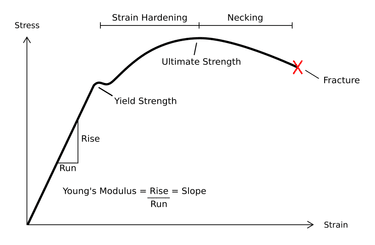If you want to be a good structural engineer, the idea of the modulus of resilience is a must for you. Resilience is actually is a term of materials science. The capability of a body to imbibe energy, when the body deformed in its elastic limit.
In this article, the term modulus of resilience will discuss broadly. Stay with us to enrich your civil engineering knowledge. Cheers!!
Modulus of Resilience
In the elastic limit, the maximum amount of energy that can be absorbed by a material per unit volume without creating any permanent deformation is called Modulus of Resilience.
It is proportional to the area under the elastic portion of the stress-strain diagram. 1
In other words, if you provide force in a body, the quantity of absorbed energy within a certain limit is known as modulus of resilience. Lastly, the limit is the elasticity limit and It is normally denoted as ‘μ’. Sometimes we denote this as ‘Ur’ too.
The modulus of resilience varies from material to material. Do you know why? Because the elasticity limit is not constant for varying materials. {adselite}
How to Calculate the Modulus of Resilience
Okay, at this moment we have some ideas about resilience and modulus of resilience. Let's see how to calculate the modulus of resilience.
From the definition we know, "Resilience" is an engineering term that refers to the amount of energy a material can absorb and still return to its original state. The modulus of resilience ‘μ’ for a given compound represents the area under the elastic portion of the stress-strain curve for that compound, and is written as:
μ = σ12 ÷ 2E
Where,
μ is the modulus of resilience,
σ1 is the yield strain and
E is Young's modulus.
There is also a way to find out the modulus of resilience from the stress-strain diagram.

Figure 1: stress-strain diagram
Accordingly, In the figure, there is a stress-strain diagram. The area under the linear portion of a stress-strain curve is the resilience of the material. If you integrate the stress-strain curve from zero to elastic limit, you will find the modulus of resilience.
Unit of the Modulus of Resilience
As we know, the unit of the Modulus of Resilience is nothing but the quantity of energy absorbed by per unit volume of a body. So, in the SI system, the unit will clearly be Joule per cubic meter (J.m-3).
It is also provable by the stress-strain diagram, which is below.
From figure 1,
μ = Area underneath the stress-strain (σ–ε) curve up to yield = σ × ε
μ [=] Pa × % = (N·m−2)·(unitless)
μ [=] N·m·m−3
μ [=] J·m−3
Finally, a civil engineer or structural engineer, you will always have to work with materials. The parameter modulus of resilience expresses the elasticity limit of a body in a passive way. It also symbolizes the load-bearing capability of a body.
Moreover, if you are a student of civil and structural engineering, you will find many more applications of the modulus of resilience in your future academic activities.
So, hopefully, this article will help you a lot!
1. https://www.engnetglobal.com/tips/glossary.aspx?word=Modulus+of+Resilience+(ur)

